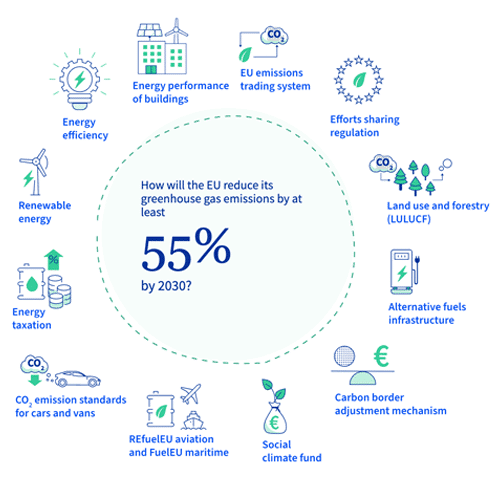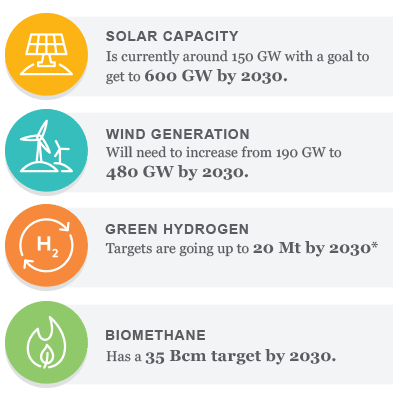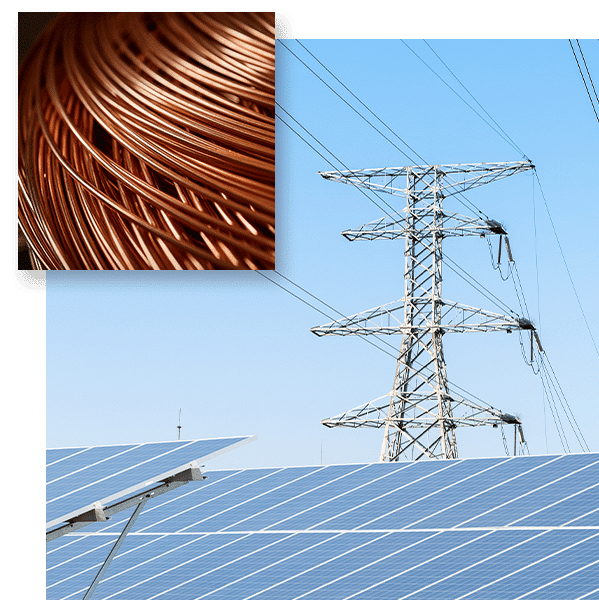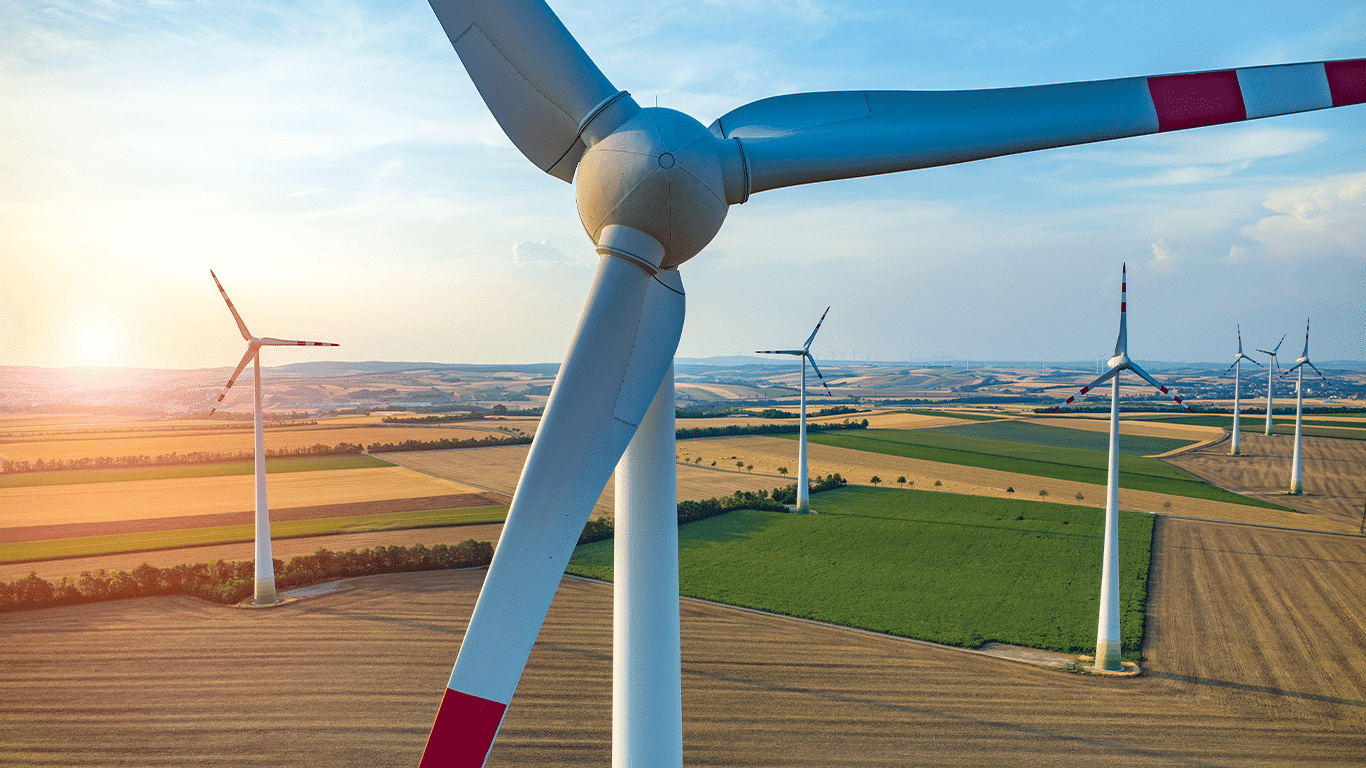The need for an energy transition away from fossil fuels has never been more urgent, especially in Europe. Not only are we facing the results of the latest Intergovernmental Panel on Climate Change (IPCC) report that says we are nearly out of time, but we are also in a time crunch to diversify away from Russian sources of energy in response to the crisis being faced by the people of Ukraine. As a result of sanctions imposed by European countries in opposition to this aggression, Russia has retaliated by cutting natural gas supply to the rest of Europe.
With limited time and vast need, Europe is preparing for a rapid energy transition away from fossil fuels and toward renewable resources. This blog will outline several of the challenges the continent will need to navigate to ensure success along the journey.
Changes to European Renewable Energy Legislation

Image source: “European Council’s Fit for 55 infographic: What is included in the Fit for 55 package?”
The desire to transition away from fossil fuels is not a new pursuit in Europe. The continent has been making changes to legislation and taking small steps for a while now. However, it has not yet faced this level of urgency.
In July 2021, the European Commission initially published the Fit for 55 package as a part of the European Green Deal. The initial goal established plans to reduce greenhouse gas (GHG) emissions by 40% by 2030, but with the enactment of Fit for 55, the GHG reduction goal was increased to 55%. And for renewable energy, the goal increased from 40% to 45%.
As a direct response to Russia, the European Commission rolled out REPowerEU to help liberate Europe from fossil fuels by 2030. The main goals of the plan are to make smarter investment decisions to save energy, produce more clean energy, and diversify energy supplies. With respect to the previous targets, the new legislation expects to raise renewable energy generation capacity by 169 GW to 1,236 GW by 2030.
The key players in the renewable energy space each have their own aggressive installation targets set:
 * To increase its competitiveness. New hydrogen legislation is expected from the EU Commission
* To increase its competitiveness. New hydrogen legislation is expected from the EU Commission
In order to establish this new capacity for renewables, Europe will need to front a sizeable investment — about 210 billion euros between 2022 and 2027. While that number may seem exorbitant, these changes to the energy infrastructure will ultimately create massive savings for the continent. According to the European Commission’s Q&A website, Europe will no longer need to spend 80 billion euros in gas imports, 12 billion euros in oil imports, and 1.7 billion euros in coal imports per year by 2030. In addition to becoming a net cost reduction, these changes will eventually deliver the energy independence that Europe needs.
Current Challenges to a European Energy Transition
While being in step with the European Commission on these changes is a great start, there are still a host of challenges that European countries will face to fully transition their energy sector. First up: how will countries speed up renewable energy production to meet the aggressive targets set forth in the legislation?
A major issue affecting the speed of production is permitting. It has become very difficult to obtain permits for new renewable energy projects due to administrative hurdles across the continent. The European Commission is aware of these difficulties and has published a document with recommendations on how to speed up permitting. Countries like Spain and Poland are establishing proposals of their own to ease permitting. For instance, in Spain, the ministry approved a decree allowing solar projects smaller than 150 MW and wind farms smaller than 75 MW to bypass the Environmental Impact Assessment process, although these projects still must meet preliminary requirements.
Another hurdle is the recent proposal introduced by the European Commission to intervene in the market, putting a revenue cap of 180 euros per MWh on renewable energy generators, which is being levied to protect customers from historically high energy costs heading into winter. Renewable generators have been targeted because they can earn exorbitant profits by bidding into the market at near zero marginal costs, as they are not exposed to the currently high natural gas prices. While such market interventions have good intentions, European leaders must implement such policies in such a way that does not discourage investment in renewable energy infrastructure and constrain Europe’s ability to achieve its REPowerEU targets.


Other concerns are centred on commodity supply and grid stability. Copper is essential in many renewable energy solutions—building interconnections, electric vehicle chargers, solar panels, wind farms, and more. Copper supply could be in jeopardy as the current supply may not be enough to meet the increased demand from heightened production plans.
Beyond commodities, there is also the issue of grid stability in Europe. Increasing the number of intermittent sources, like renewables, is expected to challenge the balancing of the grid in the years to come. For example, with coal and gas, you can decide when to turn on/off production, but that is not the case with renewable sources like wind and solar. To solve this, an influx of energy storage solutions is required; however, so far, only five countries in Europe currently have energy storage targets. Another potential solution to help balance the grid could be to increase the interconnection between countries.
We have yet to see how Europe will overcome these challenges, but we know that the continent is actively working on solutions in order to meet the aggressive targets that have been set.
Making the Energy Transition to Renewables a Reality
Europe has faced energy struggles over the past few years, but nothing like the crisis stimulated by the current war in Ukraine. While the situation is dire, it has unequivocally spurred government leaders to establish a real renewable energy transition plan. We have witnessed quick policy changes, ambitious target setting, and an increased focus on much-needed new technologies, like hydrogen.
We will be keeping close tabs on progress and advising our clients on how to build out their own targets in light of the shifting energy landscape in Europe to make the energy transition to renewables a reality. If you would like to discuss your organisation’s renewable energy procurement strategy in Europe, please contact us.


